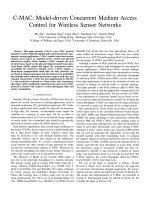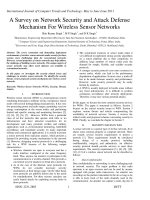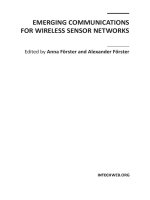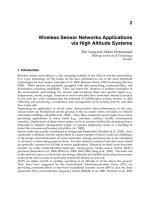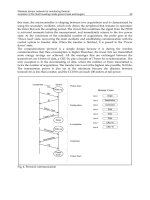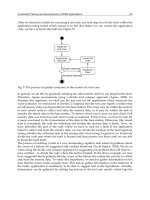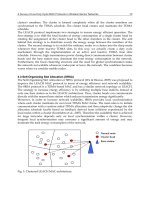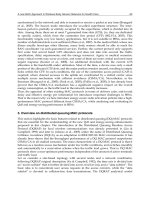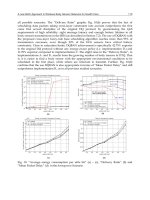FED: FUZZY EVENT DETECTION MODEL FOR WIRELESS SENSOR NETWORKS pptx
Bạn đang xem bản rút gọn của tài liệu. Xem và tải ngay bản đầy đủ của tài liệu tại đây (255.57 KB, 17 trang )
International Journal of Wireless & Mobile Networks (IJWMN) Vol. 3, No. 6, December 2011
DOI : 10.5121/ijwmn.2011.3603 29
FED:
F
UZZY
E
VENT
D
ETECTION MODEL FOR
WIRELESS SENSOR NETWORKS
HadiTabatabaee Malazi
1
,Kamran Zamanifar
1
and Stefan Dulman
2
1
Department of Computer Eng., University of Isfahan, Iran
{tabatabaee, zamanifar}@eng.ui.ac.ir
2
Embedded Software Group, Delft University of Technology, The Netherlands
A
BSTRACT
Event detection is one of the required services in sensor network applications such as environmental
monitoring and object tracking. Composite event detection faces several challenges.The first challenge is
uncertainty caused by variety of factors, while the second one is heterogeneity of sensor nodes in sensing
capabilities. Finally, distributed detection,which is vital to facilitate uncovering composite events in large
scale sensor networks, is challenging.We devised a new fuzzy event detection model which is called FED
that benefits from fuzzy variables to measure the intensity as well as the occurrenceof detected events.
FED uses fuzzy rules to define composite eventsto enhance handling uncertainty. Moreover, FED
provides a node level knowledge abstraction, which offers flexibility in applying heterogeneous sensors.
The model is also applicable to a clustered network for distributed event detection. The simulation results
show that FED is less sensitive to environmental noise and performs better in terms of percentage of
detected eventscompare to a similar approach.
K
EYWORDS
Wireless sensor networks, Composite event detection, Fuzzy event detection (FED), Heterogeneity,
Uncertainty
1.
I
NTRODUCTION
Event detection is a popular service in environmental monitoring [1]–[3] and object tracking [4]
applications.Ambulatory medical monitoring [5], vehicle tracking [6], [7] and military
surveillance [8] are some sample applicationsthat event detection plays a key role. The
popularity of this service is not limited to the applicationlayer. Several wireless senor network
middlewares [9]–[14] provide the required primitives, such as event notification to
facilitateevent detection tasks in various applications. “Event detection is a way to dig
meaningful information out of thehuge volume of data produced” mentioned S.Li in [15].
Events are generally categorized into simple (atomic) and composite (complex) ones. Simple
events can be detectedby an individual sensor type, whenever the sensed value is above/below
the predefined threshold, while compositeevents (CE) are those that cannot be detected by a
single sensor type and require collaboration among various types.
Composite event detection poses several challenges. One of the issues is the effect of
uncertainty in the detectionprocess. Environmental noise, message collision, and hardware
malfunctioning are some of the factors that maycause uncertainty. Uncertainty sources not only
affect the detection of simple events at node level, but they alsoaffect CE detection in fusion
points causing both false negatives and false positives. The node density also introducessome
challenges. A low node density increases the chance that none of the notifications reach the
International Journal of Wireless & Mobile Networks (IJWMN) Vol. 3, No. 6, December 2011
30
fusion point,while a higher density introduces a collision problem when nodes attempt to
transmit simultaneously.
Event detection applications may use variety of different sensor types to uncover composite
events using heterogeneoussensor nodes. The main reasons for applying heterogeneous sensor
nodes are hardware constraints and energyconsiderations. Therefore, each node may not be able
to detect a composite event based on its local observations.Consequently heterogeneous nodes
are required to collaboratively detect composite evens. For example they maysubmit the
detected simple events to an aggregation point to detect composite events [16].
The growing trend toward cyber-physical systems [17]–[19] introduces new desired properties
such as knowledgeabstraction and in network processing. Event notification part of the
traditional event detection systems does notcompletely fulfil these properties. The basic form of
an event notification is a tuple consist of event name, reportingnode ID and detection timestamp
which only reports the occurrence of an event in the binary form of true / false.To provide more
information on the detected event, the sensed value field can be added to the notification tuple.
Theproblem with the latter form of notification format is that the fusion point should have the
knowledge to interpretthe sensed value to estimate the intensity of the reported event which
leads to spread the interpretation knowledgeof sensing values. Consequently, it results in
reducing flexibility especially in heterogeneous sensor networks sincemodifying the threshold
of the sensed values should be applied in many nodes. Moreover, it puts the burden
ofinterpreting the sensed value of the event fusion point which leads to decrease of inside
network processing.
Energy efficiency is also one of the main challenges for most of the sensor network services and
applications.Traditionally, nodes submit the sensed values of interest to the base station for
information fusion. The centralapproach is prone to several shortcomings such as overspending
bandwidth and higher energy consumption, sincenearby nodes transmit the same event
redundantly. Reducing the number of message transfers has a considerableimpact on the energy
consumption of sensor nodes. The alternative approach is to use distributed event detectionby
contributing several fusion points such as cluster heads in a clustered network. Distributed event
detection alsofaces several challenges such as dynamic topology and diversity of available
sensor types in each cluster.
The last challenge is the scalability and dynamic nature of large wireless sensor networks.
Considering a clusterednetwork, various types of sensor nodes may join or leave a cluster
making it difficult for a cluster head to keep trackof available sensor types especially in
networks with large clusters. A mechanism is required to provide the densityof available sensor
types in the cluster. The information will help adaptive event detection, since each cluster
head(event fusion point) will make a more accurate decision to either wait for another event
type, or report a compositeevent based on previously received events.
There are considerable amount of published papers that tackle the challenges from different
perspectives. Wecategorize them into four groups. Application specific event detection
approaches [5], [7], [8], [20] are the firstcategory that target issues like energy efficiency,
accuracy, and application specific challenges. Their main goal is todevised application-specific
tailored solutions. Second category of researches attempts to provide required primitivessuch as,
efficient notification service mechanism in the middleware layer [11], [12], [14] to enhance
event detectionapplications. They usually consider idealistic models for example in
communication and do not address the possibleminor problems such as false positive detection
of congestion of communication links. The third group of researchesaddress the uncertainty
[11], [15], [21] in event detection, and finally the last category of researches focus ondistributed
International Journal of Wireless & Mobile Networks (IJWMN) Vol. 3, No. 6, December 2011
31
approach of event detection [22]–[24]. The main goal is to reach a consensus between detecting
nodesin an efficient way in terms of energy and accuracy.
In this paper we devised a generalized model called FED for composite event detection. FED
benefitsfrom fuzzy modelling in several ways.FED applies fuzzy variables to report simple
events and their intensity in anabstracted format. Fuzzy membership functions are used for each
sensor type to map the sensed values to fuzzyones. Therefore, the fusion points do not need the
interpretation knowledge of individual sensor types resulting in asimplification of using
heterogeneous sensors. Fuzzy operators are applied to aggregate the reported events. We
alsodefine composite events as fuzzy rules. FED is fully compatible with our previously
designed clustering scheme,called DEC [25]. It can also be integrated with our density
estimation algorithm [26] to support clusters with theinformation on available sensor types. We
evaluated the approach in different node densities, environmental noise,and sensor false
detection rate. The results support the idea that FED is less sensitive to uncertainty sources.
Thedevised fuzzy model can be applied in distributed detection for a clustered network where
event notifications areaggregated in cluster heads.
The rest of the paper is organized as follows. In the next section we present the related work.
The distributedcomposite event detection problem is formally discussed in Section 3. FED
model is introduced in detail in Section4. In Section 5 the model is evaluated and finally we
conclude in Section 6.
2.
R
ELATED WORK
A wide range of research has been published on event detection in wireless sensor networks.
The focus of attention varies from application specific detection to enhancement of
middlewares. Some concentrate on uncertainty in event detection while other devise approaches
for distributed aspect of detection. In the following we briefly review some of them.
2.1. Application specific event detection
Some of the published research is dedicated to detect events in a particular application such as
vehicle tracking,medical diagnosis and military surveillance.
Keally et al. in [7] devised an event detection framework to fulfil user specific requirements
mostly on objecttracking. The framework explores the sensing capability of nodes firstly, to
perform collaboration between nodes tomeet the required accuracy based on user demands
efficiently and secondly, to change detection capabilities basedon runtime observation
adaptively.
Hill et al. in [20] reported their experiment in predicting possible events, based on monitoring
and analysing a received stream of data sensed by thousands of sensors in an oil field. They
introduced an infrastructure foranalysing event detection by real time monitoring in order to
detect possible failures. The framework uses fourtiers including, user tier, early event warning
tier, sensor publisher tier and ontology tier to address the challengessuch as fast response time,
maintaining a long history of events, and combining reported events.
Shih et al. in [5] devised an automated approach for detecting seizure in epilepsy patients. Apart
from medicalrequirements, building a light weight device with fewer electrodes is considered as
requirements for the target system.The use of wireless technology helps in omitting wires which
results in lighter devices. They apply machine learningtechniques such as a support vector
machine (SVM) classifier to construct reduced channel detectors. Consequentlythe seizure is
detected with fewer electrodes.
International Journal of Wireless & Mobile Networks (IJWMN) Vol. 3, No. 6, December 2011
32
Tian He et al. in [8] design a military surveillance system that enhances a group of sensor
devices to detectand track the positions of moving vehicles cooperatively. The main goal is to
alert the command and control unitwhenever an event of interest such as moving vehicle
happens. Four major requirements are considered for thetarget approach including, longevity,
adjustable sensitivity, stealthiness and effectiveness in precision and locationestimate.
The aforementioned research concentrates on a specific application and devises the solutions
based on specificapplication conditions. Consequently they do not provide a generic solution
which can be applicable to most of theapplications.
2.2. Middlewares for event detection
Some of the researches concentrate on devising middleware [9], [10], [12], [14] to facilitate
applications forefficiently reporting the detected events. In the following, we briefly review
features devised by middlewares, suchas TinyDB [9], Impala [10], and Mires [12].
Event based query is one of the facilities that TinyDB [9] provides for event detection
applications. This type ofquery is triggered whenever an explicit event has happened. In other
words, based on the sensed value the specifiedevent will raise an interrupt and the query will be
executed. In order to use this facility the programmer should writea component to introduce the
event and the signals. The defined events can be further used in queries wheneverrequired.
Impala [10] provides an event based programming model for applications. It assigns a specific
middleware agentcalled event filter to fulfil the programming model requirements. The event
filter agent is responsible for capturingand dispatching detected events to other middleware
agents as well as applications.
Souto et al. in [12] devised a publish/subscribe middleware called Mires. It provides primitives
for publishingdetected events for the subscribed nodes. The publish/subscribe approach used in
Mires provides an asynchronouscommunication between the elements of a network. This is a
valuable advantage in a dynamic nature of WSN. Theevent detection mechanism in Mires has
three phases. In the first phase nodes advertise their sensing capabilitiesas Topics. The
advertised messages are then sent to the sink node via a multihop routing protocol. In the
secondphase user applications connect to the sink and subscribe those sensing capabilities
which they are interested in.In the last phase subscribed messages broadcast down the network.
Receiving the subscribed messages, nodes cannotify the detected events (topics).
Middleware usually addresses the node level event capturing and dispatching. They provide a
programming modelto raise events, which are usually simple events, based on the sensed
values. The distribution and aggregation ofthese events is the second aspect of these
middlewares. On the other hand they do not address the detection ofcomposite events. Besides,
they usually do not specify the architecture for distributed detection. Consequently, theseaspects
are mainly forwarded to application layer.
2.3. Uncertainty in event detection
Several approaches have been devised so far to cope with the effect of uncertainty in event
detection.
Heinzelman et al. [11] has introduced a proactive service oriented WSN middleware called
MiLAN. One of theinteresting aspects of the middlware is the capability of switching between
sensors with different sensing accuracy.MiLAN is able to handle heterogeneous nodes with
different sensing accuracy (Quality of Service). Applicationsrunning above the middleware
International Journal of Wireless & Mobile Networks (IJWMN) Vol. 3, No. 6, December 2011
33
layer are powered by the capability to identify their accuracy needs based onapplication states.
Generally, uncertainty in event detection contains wider range of issues than QoS. MiLAN isa
remarkable research in dynamically handling accuracy in sensing but it does not address issues
such as falsepositive detection, event notification loss and aggregating uncertainties.
S.Li et al. in [15] has defined an event detection service (DSWare) using a data centric
approach. It supportsdetecting CEs in a sensor network with heterogeneous nodes. An
application program can register events bysubmitting an SQL-like statement to a group of
specified nodes. In order to address CEs, sub-event sets are definedin the statement. The
definition of a sub-event consists of several parameters, such as a confidence function anda
minimum confidence value for detecting it. To cope with uncertainty DSWare uses confidence
functions. Aconfidence function takes occurrence of sub-events, in a Boolean data type format,
as an input parameter andcomputes a numeric value showing how likely the CE has happened.
DSWare aggregates the reported events alongthe path to the sink. Consequently, it is not
applicable for a clustered network. It also does not provide node levelabstraction in interpreting
the sensed values.
Ambiguity in knowledge acquisition for defining composite events is the issue that Manjunatha
addresses in[27]. According to the proposed approach, sensors submit their sensed values to an
aggregation point. The meanof transmitted values are considered as aggregated value. Then the
aggregated value is fuzzified and the inferenceengine looks for any possible composite event,
defined as fuzzy rules. Although the approach has some similaritieswith our work, our model
differs on several points from [27] in several points. Firstly, Manjunatha in [27] does notaddress
false positive detection issues. Secondly, the proposed approach does not consider unreliable
communicationand message loss which may cause uncertainty in event detection. Thirdly,
sensor nodes transmit the sensed values,which violate node level abstraction in interpreting.
Besides, the aggregation method is not appropriate for falsedetection situations. Finally, it
seems that the inference engine does not consider time and location correlation indetecting
composite events.
Samarasooriya et al. [21] have introduced a fuzzy modelling approach in dealing with
uncertainty. The mainfocus is the varying degrees of accuracy in local sensors, specifically the
local sensors error probabilities whichare varying in time in a non-random fashion. In other
words, they target node level uncertainty in detecting events.They modelled the error
probabilities with fuzzy quantities using membership functions. They used a
probabilisticapproach to fuse the local sensor decisions and formally prove the performance of
their model. Although theytry to model node level error probability, they do not devise a
solution at fusion point which includes unreliablecommunication.
2.4. Distributed event detection
From distributed detection point of view,several remarkable researches published so far.
Viswanathan et al. in [22] analyze several distributed detection (distributed signal processing)
architectures byapplying Neyman-Pearson formulation. They investigate the computational
complexity in achieving the optimalsolution. Parallel topology with/without fusion center as
well as serial and tree topology were studied. They comparethe serial architecture, in which
each node makes a decision based on its observation as well as the received decisionsfrom its
neighbors and then forwards its decision to the next node in a serial way. One of the important
outcomesof the research is, for the case where large number of participate in the distributed
detection process, the probabilityof missing event goes to zero with a much slower pace in the
serial architecture compared to the parallel one.
International Journal of Wireless & Mobile Networks (IJWMN) Vol. 3, No. 6, December 2011
34
Kumar et al. in [28] devised a framework for developing distributed data fusion applications
called DFuse. Itconcentrates on two main aspects. The first one is providing a wide range of
fusion APIs to facilitate applicationsin complex information aggregation such as video streams.
The second characteristic is the distributed algorithmfor placement of fusion function. The main
goal is to find out the optimum placement of fusion point to minimizecommunication cost.
DFuse provides a heuristic approach to choose a suitable fusion point based on predefinedcost
function. The placement process re-evaluated periodically to address network dynamics.
3.
PROBLEM
DEFINITION
We consider a network consist of m heterogeneous nodes, each node may have different subset
of availablesensors.
ܰ = {݊
:݅ ∈ ݉} (1)
Let v be the available sensor types in the network and C
i
the capability tuple of node i. Each
element in the C
i
represents a flag for a sensor type. The value of one for s
k
indicates that the
node is equipped with sensor type kand value of zero shows nonexistence.
ܥ
= (ݏ
:݇ ∈ݒ) (2)
Each node sends its observation upon detection of a simple event. Let y
i
be a reported local
observation ofsensor node i and u be the global (fusion point) decision on composite event
detection. The Eq. 3 shows themapping of local decisions to the composite event detection.
ݑ =ߛ
൫
ݕ
ଵ
(
.
)
,ݕ
ଶ
(
.
)
,…,ݕ
(
.
)
൯
(3)
Let ߁
(
ߛ
,ߛ
ଵ
,ߛ
ଶ
,…
)
be the set of rules that defines composite events, where ߛ
(.) is the
definition of a samplecomposite event. Considering the following probabilities, the goal of the
model is to increase Λ(u) which is thelikelihood of detection. In the realistic model transmitted
observations may fail to reach the destination due tomessage loss. Besides, sensor nodes may
have false positive detection due to various reasons including hardwaremalfunctioning.
P
F
: P(u = 1| ܪ
): global false alarm probability
P
D
: P(u = 1| ܪ
ଵ
): global detection probability
P
M
: P(u = 0| ܪ
ଵ
): global miss probability
Λ(u) =
(୳ | ு
భ
)
(
୳
|
ு
బ
)
(4)
In general three conditions are required to detect any CE. These conditions are:
1) In order to detect any CE, a group of predefined simple event types must have been
detected. That is, a CE is defined as a set of simple event types.
2) The occurrence timestamp of the reported simple events should be within a limited time
period (called detection window), which has been defined in the CE definition.
3) The nodes, reporting the simple events should be close enough in terms of geographical
distance. That is, in order to infer any correlation among simple events, there should be
rational physical distance among reporting nodes. The rational distance between nodes
can be calculated based on the sensing range of each sensor. It can also be measured in
terms of hop counts.
Given the above detection requirements, the devised approach should fulfil the following goals.
•
Detect composite events in the presence of message loss and false positive
simple event detection.
•
Support heterogeneity of sensor nodes in terms of sensing capability.
International Journal of Wireless & Mobile Networks (IJWMN) Vol. 3, No. 6, December 2011
35
•
Be expendable for distribute detection in large scale networks.
4.
FED
MODEL
In this section we describe different aspects of the model. First, we describe the network
architecture and in thesecond part, we explain event notification. In the third part, we present
composite event detection and finally, weaddress uncertainty problem.
4.1. Network architecture
FED uses clustered network architecture to perform distributed event detection and prevent
redundant submissionof simple events to sink node. The cluster heads have the responsibility of
aggregating the reported events withintheir clusters and forward the detected composite events
to the sink node.
Choosing an appropriate clustering scheme is an important issue in the efficiency of the model.
Recall from thedefinition of composite events, a variety of sensor types are required to
collaborate in order to detect a compositeevent. Therefore, the clustering scheme should
maximize the diversity of sensor types in each cluster to increasethe cluster capabilities in
detecting composite events. Traditional clustering schemes such as [29]–[34] fail to fullysatisfy
this requirement. They usually do not consider sensor diversity as a clustering parameter.
We have introduced a diversity base clustering scheme called DEC [25] to increase the
capability of detectingvarious composite events. DEC performs four phases, which are
initialization, clusterjoining, migration, andtermination, to generate clusters with maximum
possible diversity of sensor types. It applies a cost functionthat uses the residual energy level of
a node and the diversity of its neighboring nodes, to elect a cluster head. Tohandle the dynamic
nature of wireless sensor networks, migration phase of the algorithm has the duty of
balancingthe capabilities of the cluster in case where some sensors fail. That is, whenever a
scare sensor type fails, thecluster head invites nodes with the same sensor type to migrate. The
invitation will be accepted, if it is granted bythe node’s current cluster head. The simulation
results in [25] show that it produces clusters with higher sensingcapabilities for enhancing event
detection applications. For more detailed information on DEC please refer to [25].
It should be added that there is also an on-going research to devise a clustering scheme for the
mobile nodes toadaptively maximize sensor diversity in each cluster. The first step is to estimate
the diversity of sensor types [26]in a mobile network. The estimation will be further used in
order to provide the required clustering scheme for themobile network.
4.2. Simple events
Simple event notification is the building block of FED. We apply fuzzy logic [35] to provide a
node levelabstraction on interpreting the meaning of the sensed values. Based on FED model,
we fuzzify the sensed valuesinside the sensing node. One of the advantages is to provide a node
level abstraction on the meaning of the value.Therefore, the aggregation point is not required to
have a full knowledge over all sensor types in the heterogeneoussensor networks.
In FED each sensor type is associated with a fuzzy variable and consequently each fuzzy
variable has severalfuzzy values. The values are defined based on the specified simple events by
the application. Although submittingthe fuzzy value of the detected simple event is adequate for
applications that only need simple event detection,composite event detection applications need
more information on the membership degree of the fuzzy value inorder to aggregate the simple
event notifications.
International Journal of Wireless & Mobile Networks (IJWMN) Vol. 3, No. 6, December 2011
36
To convert the sensed values into fuzzy ones, a membership function is required. Figure 1
shows a samplemembership function for a heat sensor. The X axis is the temperature degree in
Celsius while Y axis shows themembership degree. Values below 26 are out of concern as the
threshold is set to be 26°C.
Figure1. Sample fuzzy membership function for heat sensor
The next step is to prepare the event notification message. Simple event notifications in FED
consist of fivefields. Some of these fields are similar to the traditional event notification format.
Equation 5 shows the simpleevent notification in FED where e
name
, n
id
, t, f
value
and d
membership
are
event name, node ID, event time, fuzzyvalue and membership degree respectively.
y
i
= (e
name
,n
id
, t , f
value
,d
membership
) (5)
For example, in an indoor fire detection application the temperature above 26° should be
reported. Consider anode with the ID of 43 that has sensed the temperature of 37°at 12:23:39.
The following event notification willbe reported. Temp shows that a temperature event has
happened. The second field shows the ID of the reportingnode while the third element shows
the time (more precise time formats can be used to present timestamp field) inwhich the event
has been detected. The fuzzy value and related membership degree are the fourth and fifth
fieldsrespectively.
event = (Temp,43,12:23:39 GMT,serious,0.20) (6)
4.3. Composite events
Recall from Section 3, the occurrence of a set of predefined simple events is one of the
conditions of detectingcomposite events. Considering the fact that simple events are reported as
fuzzy notifications, we define compositeevents as fuzzy rules. Here is a sample composite event
that has been defined in a fuzzy rule format.
ࢽ
:If Heat is MEDIUM and Humidity is LOW and Smoke is Medium then Fire is SERIOUS
The IF clause shows the set of simple events required to detect the composite event, and the
THEN clausespecifies the composite event name. In the composite event definition, each simple
event is associated with a fuzzyvalue. The values are used to estimate the likelihood of the
composite event.
FED uses two aggregation methods to fuse the transmitted simple events. The first method is
used to fuse thesimple events of the same type and the second one is used for the final
aggregation. The fuzzy operator OR is usedto aggregate same type simple events.
International Journal of Wireless & Mobile Networks (IJWMN) Vol. 3, No. 6, December 2011
37
The next step is to investigate if the possibly correlated notifications can satisfy any fuzzy rule.
In order tocalculate the occurrence degree of the detected CE, notifications are aggregated
weighted average function. Theactual weight for each simple event type of a specific fuzzy rule
(composite event) is chosen based on application requirements. The more important event types
will weight higher compared to less important ones. It is also possibleto adaptively choose the
weights based on the redundancy of each simple event that has been received. The result ofthe
fuzzy rules will be the composite event, its fuzzy value, and the degree of membership. The
fuzzy value showshow serious is the detected event and the degree of membership shows the
likelihood of the detected compositeevent. Higher membership degrees indicate that the CE has
happened with higher certainty and lower values, viceversa.
4.4. Detection process
The event detection process consists of three main activities, which are simple event detection,
composite event detection, and event stream maintenance.
Ordinary sensor nodes are responsible for detecting simple events. The activity starts when a
sensor node detectsan event (event name) based on the sensed values and predefined threshold
values for the simple events. In the nextstep, the node maps the sensed value to a fuzzy one
(fuzzy value) using the fuzzy membership function, andcalculate the corresponding membership
degree. Finally in the last step, the complementary information such asnode ID and detection
timestamp are added to the event notification and submitted to the fusion point.
The coordinator is responsible for composite event detection based on the received event
notifications from itscluster members. The process triggering mechanism is a design issue
aspects of the process. The process of detectingcomposite events can be triggered either by
arrival of new event notification, or by a timer. The former providesfaster detection with the
price of increased processor consumption, while the detection speed in the latter is sensitiveto
the timer value. The occurrence frequency of an event, which is an application specific
parameter, is one of thefactors that play an important role in choosing either case.
One of the other responsibilities of the coordinator is to analyze the correlations between the
received notifications.In FED the event correlation is investigated from two different aspects.
The first parameter is the time distance(detection window) between the reported simple events
and the second one is the physical distance between thereporting nodes. The output of the
correlation analysis step is a set of event notifications that should be examined touncover a
possible composite event. Then the correlated notifications are aggregated based on the methods
describedin Section 4.3.
Maintenance of the received event streams at the fusion point helps to improve the efficiency of
the model. Oneof the main responsibilities of cluster heads in FED is to keep track of the
correlated simple events. Therefore, thereported event stream has to be scanned frequently by
the cluster head. It is highly recommended to keep the storedstream as short as possible to save
memory and processor resources. One of the ways to keep the stream shortis to set an expiration
time for the stored events. Consequently, the expired event notifications will be
removedautomatically. Two parameters should be considered in defining the expiration time
effectively. The first parameteris the largest detection window for the composite event and the
second one is the time synchronization accuracy[36].
4.5. Uncertainty
Generally, a predefined set of simple events should happen in order to be able to detect a
composite event. Thereare cases where at least one of the required simple events misses, due to
various reasons. To cope with the problem,FED calculates the occurrence likelihood of the
International Journal of Wireless & Mobile Networks (IJWMN) Vol. 3, No. 6, December 2011
38
composite event. The calculation is similar to aggregation of simpleevents. The output of the
calculation is a membership degree of a possible composite event in the absence of arequired
simple event. FED uses threshold called acceptance ratio, to recognize the reported simple
events as acomposite event. Lower values for acceptance ratio threshold will result on higher
false positives while highervalues will disable the uncertainty handling of FED.
For example consider the fuzzy rule of Section 4.3 and the following event notifications from
the two nearbysensor nodes.
y
1
= (heat,12,12:23: 40 GMT,medium,0.90) (7)
y
2
= (smoke,20,12:23: 39 GMT,medium,0.85) (8)
In the absence of the third simple event, FED calculates the average of the membership degrees
which is 0.583. Ifthe acceptance ratio for the rule is below the calculated number, the composite
event will be detected.
5.
EVALUATION
To evaluate the performance of the introduced model on detecting composite events under
uncertainty sources,several of simulation configurations were setup. Before analyzing the
achieved results, we would like to introducethe simulation tool first.
5.1. Simulation environment
We have developed a simulation environment based a software agent development tool called
JADE [37]. JADEis a framework for developing multi-agent systems. These are some of the
advantages of using JADE for simulatingwireless sensor network algorithms.
• The framework encapsulates the network protocol stack and helps to ignore the
hardware level details of sensor nodes. Considering each node as a software agent gives
us a chance to analyse the higher level behaviour of the algorithm in the network.
• The autonomous property of software agents maps well with sensor nodes’ autonomous
nature.
• Message passing is considered as the only communication mechanism in JADE and
wireless sensor networks. That is, there are no method calls or shared memory facilities
in both cases. Arrived messages are stored in a FIFO queue in each agent in JADE
which is similar to a sensor node. Thisalso provides the means of having an
asynchronous communication.
The aforementioned features give us sufficient reasons to build our simulation based on JADE.
But in order to fitthe tool with the problem criteria, we have added five additional features.
1) Event notifications omitted randomly to simulate message loss in the network.
2) To simulate false detection behavior of nodes, a random false detection mechanism is
added to sensor nodes.
3) We have added a delay in message transmission in order to simulate propagation delay
using a Gaussianrandom generator.
4) Sensor nodes are only allowed to communicate with each other, only if they are within
each other’s transmission range. All the sensor nodes can communicate with the
coordinator in a bidirectional way.
5) An event generator creates CEs by defining the exact location randomly and sends the
message to only thosenodes that are within the sensing rage of the generated event.
International Journal of Wireless & Mobile Networks (IJWMN) Vol. 3, No. 6, December 2011
39
5.2. Simulation results
To evaluate FED, we simulated an experimental case similar to explosion detection application.
In our simulation,heterogeneous nodes are distributed in the environment uniformly random.
We use three types of sensors(SensorType1, SensorType2 and SensorType3) with equal
quantities. In each experiment a sensor field is generatedwith predefined number of nodes that
has been located uniformly distributed. 100 CEs with random locations aregenerated
periodically across the network area of 600 * 600 unit
2
. To reduce the effect of the random
distributionwe have run each experiment 50 times and averaged the results.
In the first set of experiments, we investigate the effect of sensing coverage area of a sensor and
the message lossrate on the percentage of detected composite events. Figure 2 shows the
simulation results for a network consistsof 12 nodes from 3 sensor types (4 sensors from each
type) which are deployed randomly. Besides, false simple event reports are produced randomly
with rate of 5%. The evaluation metric (Y axis) is the percentage of detectedcomposite events.
The performance of FED is compared with the approach introduced in [27]. According to
theexperiment scenario, we increase the sensing range of sensor nodes from 240 to 380 units.
The lower sensing rangerepresents less dense network, while the higher sensing ranges show the
dense ones. The reason is, in the highersensing ranges each point in the network field may be
covered by more nodes, whereas in lower sensing rangesit will be covered by fewer nodes. The
first thing that the simulation results show is that, increasing the sensingrange will provide
higher detection percentage of composite events.
To investigate the effect of message loss, we apply two different message loss rates. In the first
case 25% ofsimple event notifications are omitted randomly. The results show that FED
outperforms 15% with the sensingrange of 240 units. As the sensing range increases, both
approaches achieve higher percentage of event detection.
The results also show that FED is less sensitive to message loss. That is, the difference between
the percentagesof detected events in the lowest and highest sensing ranges for the case of 25%
of message loss is 35% for FEDand 42% for [27]. The results for the case of 15% of message
loss also support the idea.
Figure2. CE detection in a network with node density of 3 false alarm 5%.
We run the simulation with similar configuration with 24 nodes. Figure 3 shows the simulation
results, whereX axis is the sensing range and the Y axis is the percentage of detected composite
220 240 260 280 300 320 340 360 380 400
0
10
20
30
40
50
60
70
80
90
100
Sensing range of senor nodes (units)
Percentage of detected events
25% (FED)
25% [27]
15% (FED)
15% [27]
International Journal of Wireless & Mobile Networks (IJWMN) Vol. 3, No. 6, December 2011
40
events. The results show thatFED performs better in all the sensing ranges. For instance, FED
detects 57% of composite events for the casewhere sensing range is 169, while the approach in
[27] detects only 43% in the presence of 25% message loss.The difference between the
detection percentages of both approaches reduces in the dense network, due to multipledetection
of a simple event. But even in the sensing range of 268, FED detects 6% more composite
events. Moreover, similar to previous experiment, the results show that FED is less sensitive to
environmental noise. For example,the difference between the highest and lowest percentage of
event detection is 37% and 46% for FED and [27]respectively with 25% of message loss. In the
network with 15% of message loss, the difference is 30% and 40%for FED and [27]
respectively.
Figure3. CE detection in a network with node density of 3 false alarm 5%.
Figure 4 and Figure 5 shows the experimental results for the network of 36 and 48 nodes
respectively. We alsoincrease the false alarm rate to 10%. The outcome of the experiments is
similar to the previous analysis.
Figure4. CE detection in a network with node density of 4 false alarm 10%.
160 180 200 220 240 260 280
0
10
20
30
40
50
60
70
80
90
100
Sensing range of senor nodes (units)
Percentage of detected events
25% (FED)
25% [27]
15% (FED)
15% [27]
120 140 160 180 200 220
0
10
20
30
40
50
60
70
80
90
100
Sensing range of senor nodes (units)
Percentage of detected events
15% (FED)
15% [27]
25% (FED)
25% [27]
International Journal of Wireless & Mobile Networks (IJWMN) Vol. 3, No. 6, December 2011
41
Figure5. CE detection in a network with node density of 4 false alarm 10%.
In the next set of experiments we investigate the effect of message loss in detail. The network
surface is the sameas previous experiments and the quantity of each sensor type is equal to
ଵ
ଷ
of
network nodes. Figure 6 demonstratesthe percentage of detected events (Y axis) for various
message loss rates (X axis). The graph shows the results forthe network of 12 and 24 nodes and
false alarm rate is set to be 10%. The sensing range is defined in way that thesenetwork
configurations have the same node density. The sensing range for the network of 12 nodes is set
to be 239units and for the case of a 24 node network is 169 units. To calculate the proper
sensing range we use the followingequation where d, L, W, and n are network node density,
length, width, and size (number of nodes) respectively.
ݐ
=
ට
ௗௐ
ଶగ
(9)
Figure6. FED sensitivity to quantity of nodes under 10% false alarm rate
.
Similar to the previous results, FED detects more events compared to the approach introduced
in [27]. For examplein a network of 12 with 5% message loss, FED detects 5% of events that is
not detected by [27]. As the messageloss rate increase, the percentage of detected events in both
100 120 140 160 180 200
0
10
20
30
40
50
60
70
80
90
100
Sensing range of senor nodes (units)
Percentage of detected events
15% (FED)
15% [27]
25% (FED)
25% [27]
International Journal of Wireless & Mobile Networks (IJWMN) Vol. 3, No. 6, December 2011
42
approaches decrease. But the results show that FED is more robust message loss. For the case of
25% message loss in a network of 12 nodes, FED uncovers more than15% of undetected events
by [27], while in the presence of 5% message loss was 5%.
Figure 7 depicts the results for a similar experiment with 36 and 48 nodes. The node density is 3
which means that the sensing range for each node in the 36 node network is 169 units and for
the network of 48 nodes is 148units and the false alarm rate is 10%.
Figure7. FED sensitivity to quantity of nodes under 5% false alarm rate
.
6.
C
ONCLUSIONS
In this paper we have introduced a fuzzy model called FED for distributed detection of
composite events. FED supports the heterogeneity of sensor types. To perform distributed
detection, the model uses a diversity based clustering scheme in which each cluster considers
maximizing the sensor diversity of their member nodes.Therefore, the clusters are able to detect
a wide range of composite events. Besides, the model provides node level knowledge
abstraction which is a valuable characteristic in designing heterogeneous sensor networks. A
fuzzy approach is used to uncover composite events in the presence of uncertainty sources such
as message loss and false alarms. The simulation results show that FED outperforms in terms of
the percentage of detected events. The amount of improvement is significant in networks with
low node density. Besides, FED is suitable for the networks with high message loss rates.
A
CKNOWLEDGEMENTS
This research is funded by Iranian Telecommunication Manufacturing Company (ITMC).
International Journal of Wireless & Mobile Networks (IJWMN) Vol. 3, No. 6, December 2011
43
R
EFERENCES
[1] M. Ceriotti, L. Mottola, G. P. Picco, A. L. Murphy, S. Guna, M. Corra, M. Pozzi, D. Zonta, and
P. Zanon, “Monitoring heritage buildings withwireless sensor networks: The torreaquila
deployment,” in Proceedings of the 2009 International Conference on Information Processingin
Sensor Networks, ser. IPSN ’09. Washington, DC, USA: IEEE Computer Society, 2009, pp.
277–288.
[2] R. Szewczyk, A. Mainwaring, J. Polastre, J. Anderson, and D. Culler, “An analysis of a large
scale habitat monitoring application,” inProceedings of the 2nd international conference on
Embedded networked sensor systems, ser. SenSys ’04. New York, NY, USA: ACM,2004, pp.
214–226.
[3] K. Martinez, J. K. Hart, and R. Ong, “Environmental sensor networks,” Computer, vol. 37, pp.
50–56, 2004.
[4] A. Yilmaz, O. Javed, and M. Shah, “Object tracking: A survey,” ACM Comput. Surv., vol. 38,
December 2006.
[5] E. I. Shih, A. H. Shoeb, and J. V. Guttag, “Sensor selection for energy-efficient ambulatory
medical monitoring,” in Proceedings of the7th international conference on Mobile systems,
applications, and services, ser. MobiSys ’09. New York, NY, USA: ACM, 2009, pp.347–358.
[6] M. F. Duarte and Y. H. Hu, “Vehicle classification in distributed sensor networks,” J. Parallel
Distrib.Comput., vol. 64, pp. 826–838, July2004.
[7] M. Keally, G. Zhou, and G. Xing, “Watchdog: Confident event detection in heterogeneous
sensor networks,” Real-Time and EmbeddedTechnology and Applications Symposium, IEEE,
vol. 0, pp. 279–288, 2010.
[8] T. He, S. Krishnamurthy, L. Luo, T. Yan, L. Gu, R. Stoleru, G. Zhou, Q. Cao, P. Vicaire, J. A.
Stankovic, T. F. Abdelzaher, J. Hui, andB. Krogh, “Vigilnet: An integrated sensor network
system for energy-efficient surveillance,” ACM Trans. Sen. Netw., vol. 2, pp. 1–38,Feb. 2006.
[9] S. R. Madden, M. J. Franklin, J. M. Hellerstein, and W. Hong, “Tinydb: an acquisitional query
processing system for sensor networks,”ACM Trans. Database Syst., vol. 30, pp. 122–173,
March 2005.
[10] T. Liu and M. Martonosi, “Impala: a middleware system for managing autonomic, parallel
sensor systems,” SIGPLAN Not., vol. 38, pp.107–118, June 2003.
[11] W. B. Heinzelman, A. L. Murphy, H. S. Carvalho, and M. A. Perillo, “Middleware to support
sensor network applications,” IEEE Network,vol. 18, no. 1, pp. 6–14, 2004.
[12] E. Souto, G. Guimar˜aes, G. Vasconcelos, M. Vieira, N. Rosa, and C. Ferraz, “A message-
oriented middleware for sensor networks,” inProceedings of the 2nd workshop on Middleware
for pervasive and ad-hoc computing, ser. MPAC ’04. New York, NY, USA: ACM,2004, pp.
127–134.
[13] T. Abdelzaher, B. Blum, Q. Cao, Y. Chen, D. Evans, J. George, S. George, L. Gu, T. He, S.
Krishnamurthy, L. Luo, S. Son, J. Stankovic,R. Stoleru, and A. Wood, “Envirotrack: Towards an
environmental computing paradigm for distributed sensor networks,” DistributedComputing
Systems, International Conference on, vol. 0, pp. 582–589, 2004.
[14] R. Kumar, M. Wolenetz, B. Agarwalla, J. Shin, P. Hutto, A. Paul, and U. Ramachandran,
“Dfuse: a framework for distributed data fusion,”in Proceedings of the 1st international
conference on Embedded networked sensor systems, ser. SenSys ’03. New York, NY, USA:
ACM,2003, pp. 114–125.
[15] S. Li, S. H. Son, and J. A. Stankovic, “Event detection services using data service middleware in
distributed sensor networks,” in Proceedingsof the 2nd international conference on Information
processing in sensor networks, ser. IPSN’03. Berlin, Heidelberg: Springer-Verlag,2003, pp. 502–
517.
International Journal of Wireless & Mobile Networks (IJWMN) Vol. 3, No. 6, December 2011
44
[16] J. Mao, J. Jannotti, M. Akdere, and U. Cetintemel, “Event-based constraints for sensornet
programming,” in Proceedings of the secondinternational conference on Distributed event-based
systems, ser. DEBS ’08. New York, NY, USA: ACM, 2008, pp. 103–113.
[17] R. Rajkumar, I. Lee, L. Sha, and J. Stankovic, “Cyber-physical systems: The next computing
revolution,” in Design Automation Conference(DAC), 2010 47th ACM/IEEE, june 2010, pp.
731 –736.
[18] S. Ren, “Apeser 2010 keynote speech: Shangpingren,” in Green Computing and
Communications (GreenCom), 2010 IEEE/ACM Int’lConference on Int’l Conference on Cyber,
Physical and Social Computing (CPSCom), dec. 2010, p. lvix.
[19] E. Lee, “Cyber physical systems: Design challenges,” in Object Oriented Real-Time Distributed
Computing (ISORC), 2008 11th IEEEInternational Symposium on, may 2008, pp. 363 –369.
[20] M. Hill, M. Campbell, Y C. Chang, and V. Iyengar, “Event detection in sensor networks for
modern oil fields,” in Proceedings of thesecond international conference on Distributed event-
based systems, ser. DEBS ’08. New York, NY, USA: ACM, 2008, pp. 95–102.
[21] V. N. S. Samarasooriya and P. K. Varshney, “A fuzzy modeling approach to decision fusion
under uncertainty,” Fuzzy Sets Syst., vol. 114,pp. 59–69, August 2000.
[22] R. Viswanathan and P. Varshney, “Distributed detection with multiple sensors i. fundamentals,”
Proceedings of the IEEE, vol. 85, no. 1,pp. 54 –63, Jan. 1997.
[23] V. Saligrama, M. Alanyali, and O. Savas, “Distributed detection in sensor networks with packet
losses and finite capacity links,” SignalProcessing, IEEE Transactions on, vol. 54, no. 11, pp.
4118 –4132, 2006.
[24] E.Ermis and V.Saligrama, “Distributed detection in sensor networks with limited range
multimodal sensors,” Signal Processing, IEEETransactions on, vol. 58, no. 2, pp. 843 –858,
2010.
[25] H. TabatabaeeMalazi, A. Khalili, K. Zamanifar, and S. Dulman, “DEC: Diversity based energy
aware clustering for heterogeneous sensornetworks,” Ad Hoc and Sensor Wireless Networks
(Accepted).
[26] H. TabatabaeeMalazi, K. Zamanifar, A. Pruteanu, and S. Dulman, “Gossip-based density
estimation in dynamic heterogeneous sensornetworks,” in Wireless Communications and Mobile
Computing Conference (IWCMC), 2011 7th International, July 2011, pp. 1365 –1370.
[27] P. Manjunatha, A. Verma, and A. Srividya, “Multi-sensor data fusion in cluster based wireless
sensor networks using fuzzy logic method,”in Industrial and Information Systems, 2008.ICIIS
2008.IEEE Region 10 and the Third international Conference on, 2008, pp. 1 –6.
[28] A. V. U. Phani Kumar, A. M. Reddy V, and D. Janakiram, “Distributed collaboration for event
detection in wireless sensor networks,”in Proceedings of the 3rd international workshop on
Middleware for pervasive and ad-hoc computing, ser. MPAC ’05. New York, NY,USA: ACM,
2005, pp. 1–8.
[29] H. Chan and A. Perrig, “ACE: An emergent algorithm for highly uniform cluster formation,” in
European Workshop on Wireless SensorNetworks (EWSN 2004), Jan. 2004.
[30] S. Soro and W. B. Heinzelman, “Cluster head election techniques for coverage preservation in
wireless sensor networks,” Ad Hoc Netw.,vol. 7, pp. 955–972, July 2009.
[31] O. Younis and S. Fahmy, “Distributed clustering in ad-hoc sensor networks: a hybrid, energy-
efficient approach,” in INFOCOM 2004.Twenty-third AnnualJoint Conference of the IEEE
Computer and Communications Societies, vol. 1, 2004, pp. 4 vol. (xxxv+2866).
[32] S. K. Singh, M. P. Singh, and D. K. Singh, “Energy efficient homogenous clustering algorithm
for wireless sensor networks,” International Journal of Wireless & Mobile Networks (IJWMN),
vol.2, no.3, August 2010.
International Journal of Wireless & Mobile Networks (IJWMN) Vol. 3, No. 6, December 2011
45
[33] Getsy S Sara, Kalaiarasi.R, NeelavathyPari.S and Sridharan .D, “Energy efficient clustering and
routing in mobile wireless sensor network,” International Journal of Wireless & Mobile
Networks (IJWMN) vol.2, no.4, November 2010.
[34] S.Taruna, Kusum Jain and G.N. Purohit, “Power Efficient Clustering Protocol (PECP)-
Heterogeneous Wireless Sensor Network,” International Journal of Wireless & Mobile Networks
(IJWMN) vol.3, no.3, June 2011.
[35] L. Zadeh, “Fuzzy sets,” Information and Control, vol. 8, no. 3, pp. 338 – 353, 1965.
[36] B. Sundararaman, U. Buy, and A. D. Kshemkalyani, “Clock synchronization for wireless sensor
networks: a survey,” Ad Hoc Networks,vol. 3, no. 3, pp. 281 – 323, 2005.
[37] Java agent development framework @ONLINE. [Online]. Available:
